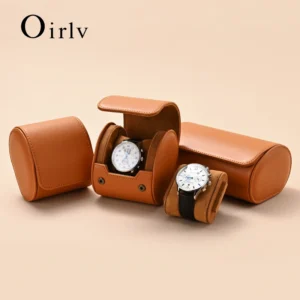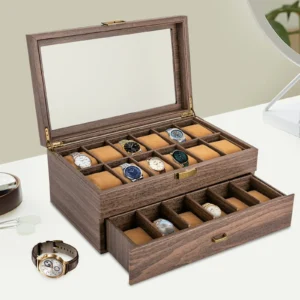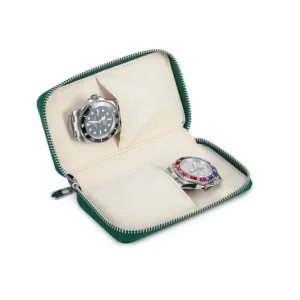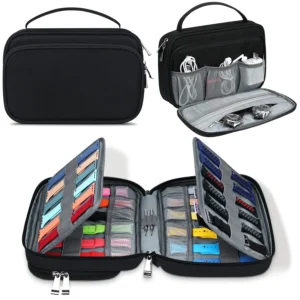For watch enthusiasts, the leather components of our timepieces and storage solutions are not just functional elements—they’re part of what makes these items special. When damage occurs, deciding between repair and replacement can be challenging. This comprehensive guide will walk you through everything you need to know to make the right choice for your prized possessions.
Understanding Leather Watch Components and Materials
Before diving into repair or replacement decisions, it’s important to understand what we’re working with. Leather components in the watch world typically include:
- Watch straps/bands that attach directly to the timepiece
- Leather-wrapped watch cases or boxes for storage and display
- Interior padding and compartments in watch storage solutions
- Travel cases designed to protect watches on the go
The quality of leather significantly impacts both its durability and repair potential. Common leather types used include:
- Full-grain leather: The highest quality, showing natural grain and developing a beautiful patina over time. Most durable and often most responsive to repair techniques.
- Top-grain leather: Second highest quality, with the outermost layer sanded to remove imperfections. Good repair candidate.
- Genuine leather: Lower quality than the above, made from the layers remaining after top selections are removed. Limited repair potential.
- Exotic leathers: Including alligator, crocodile, ostrich, and others. Require specialized repair techniques.
The quality of your leather directly influences how it ages and how well it responds to repair attempts. Higher quality leathers typically offer better repair outcomes and longer lifespans, making them sometimes worth the extra investment for repair. Proper caring for leather watch cases significantly extends their lifespan, potentially avoiding the repair-replacement dilemma altogether.
Different leathers also age differently—full-grain develops an attractive patina while lower grades may simply look worn. Understanding the leather aging process for watch boxes helps set realistic expectations about how repairs might look compared to new replacements.
Identifying and Assessing Leather Watch Damage
Accurate damage assessment is crucial in making an informed repair or replacement decision. Here’s a breakdown of common leather damage types:
| Damage Type | Minor (Repair Likely) | Moderate (Professional Repair) | Severe (Replacement Recommended) |
|---|---|---|---|
| Scratches | Surface marks that don’t penetrate leather | Deeper scratches exposing under-layers | Gouges that significantly alter structure |
| Discoloration | Light fading or small stains | Moderate color loss or widespread staining | Severe discoloration affecting entire sections |
| Cracks | Surface microcracking | Visible cracks not yet separating | Deep cracks that separate the leather |
| Tears | Small edge fraying | Clean tears under 1” with no material loss | Jagged tears or tears with material loss |
| Water Damage | Light spotting | Stiffening and moderate warping | Severe warping, mold, or rotting |
| Structural | Loose stitching | Partial separation of components | Structural failure, broken hinges/mechanisms |
When evaluating damage, consider how it affects both the appearance and functionality of your leather watch component. For valuable watches or cases, professional assessment may be worthwhile before proceeding with either repair or replacement.
Techniques for cleaning leather watch cases can sometimes reveal that apparent damage is actually just surface soil that can be addressed without full repair or replacement. A thorough cleaning should be the first step in your assessment process.
DIY Leather Watch Repair Techniques
For minor to moderate damage, DIY repair is often a cost-effective first approach. Here’s how to tackle common issues:
Basic Cleaning and Conditioning
1. Gently remove surface dirt with a soft brush
2. Clean with a leather-specific cleaner on a microfiber cloth
3. Apply leather conditioner appropriate for your specific leather type
4. Allow to fully dry away from direct heat or sunlight
For Minor Scratches:
– Use a clean finger to gently rub natural oils into the scratch
– Apply leather conditioner and buff gently
– For colored leather, matching cream can help disguise scratches
For Color Restoration:
– Clean thoroughly first
– Test color-matched leather dye on an inconspicuous area
– Apply thin layers rather than one thick coat
– Seal with appropriate leather finisher
For Minor Stitching Issues:
– Select thread that matches the original in color and thickness
– Use beeswax to strengthen the thread
– Use a leather needle and basic saddle stitch for durability
– Secure with tight knots and trim excess thread
Essential DIY Repair Supplies:
– Leather cleaner and conditioner specific to your leather type
– Microfiber cloths
– Leather color repair kit matching your leather shade
– Fine grit sandpaper (600+ grit)
– Leather glue for small separations
– Leather needles and waxed thread for stitching repairs
The right cleaning products for leather watch boxes can make a significant difference in repair outcomes. Quality products specifically designed for fine leather will yield better results than generic alternatives.
DIY repairs work best for minor issues. Know your limits—attempting complex repairs on valuable pieces without proper skills can reduce their value or cause further damage.
Professional Leather Watch Repair Services
When damage exceeds DIY capabilities, professional repair services offer specialized techniques and experience. Consider professional repair when:
- Damage extends through multiple layers of leather
- Structural components are compromised
- The watch or case has significant monetary or sentimental value
- Color matching is critical and complex
- Previous DIY attempts haven’t yielded satisfactory results
Professional leather repair specialists can offer services beyond typical DIY capabilities:
– Complete disassembly and reconstruction
– Precision color matching and blending
– Custom part fabrication for vintage or discontinued models
– Professional restitching with industrial equipment
– Specialized treatments for exotic leathers
– Restoration of leather finish and texture
When selecting a professional repair service, look for:
– Specific experience with watch components or fine leather goods
– Before/after examples of similar repairs
– Clear communication about repair limitations
– Detailed estimates and timeframe expectations
– Guarantees or warranties on their work
Expected costs for professional repairs vary widely based on damage extent and the type of leather component:
– Minor strap repairs: $30-75
– Complete strap restoration: $75-150
– Watch box hinge or structural repair: $100-200
– Extensive restoration of luxury leather watch boxes: $200-500+
For high-quality leather watch storage solutions, our leather watch boxes collection offers examples of the craftsmanship standard you should expect after professional repair.
When to Replace Your Leather Watch Component
Sometimes replacement is the better option. Consider replacement when:
- Repair costs approach or exceed replacement value
- Structural integrity is compromised beyond reliable repair
- The leather has deteriorated through its entire thickness
- Mold or mildew has penetrated deeply into the material
- Multiple previous repairs have accumulated
- The component no longer functions as intended
- You desire updated features or aesthetics
Economic considerations often drive replacement decisions. Calculate the full cost of professional repair, including:
– Base repair cost
– Shipping to specialty repair services
– Additional parts or materials
– Value of time without the component during repair
For travel cases specifically, replacement often makes sense when protection is compromised, as the primary purpose is safeguarding your timepieces. Our leather watch travel case options provide modern alternatives worth considering.
Use this quick decision checklist:
– Is the damage primarily aesthetic or functional?
– Does the item have irreplaceable sentimental value?
– Would repair restore both appearance and functionality?
– Is the repaired item likely to need additional repairs soon?
– Would you be satisfied with the likely repair outcome?
Selecting Quality Replacement Leather Watch Components
If you’ve decided on replacement, selecting the right component ensures you won’t face the same decision again soon. Here’s what to consider:
Material Quality Factors:
– Full-grain or top-grain leather for longevity
– Appropriate thickness for the component’s purpose
– Quality of dyes and finish for color longevity
– Water and stain resistance treatments
– Quality of interior materials (suede, velvet, etc.)
Ensuring Proper Fit:
– For straps: Exact lug width measurement
– For cases: Appropriate dimensions for your watch collection
– For travel cases: Sufficient padding and security features
– For display boxes: Proper slot size and cushion fit
Style Considerations:
– Matching or complementing the watch’s design era
– Appropriate formality level (casual, dress, sport)
– Color coordination with watch faces or other elements
– Stitching style and color compatibility
Custom replacements offer perfect fit and style matching but come at premium prices (typically 50-200% more than off-the-shelf options). They’re worth considering for unique or high-value timepieces.
The durability comparison of wood and leather watch cases can help inform your material choices when selecting replacements, as each offers distinct advantages in different circumstances.
Watch Accessories, Watch Holder
$94.51 Select options This product has multiple variants. The options may be chosen on the product pageSingle Watch Travel Case, Watch and Jewelry Box, Watch Roll Travel Case
Price range: $93.44 through $140.65 Select options This product has multiple variants. The options may be chosen on the product pageMen's Watch Organizer, Watch Display Case, Watch Organizer
Price range: $112.68 through $169.45 Select options This product has multiple variants. The options may be chosen on the product pageLeather Watch Travel Case, Men's Watch Travel Case, Watch Roll Travel Case
Price range: $91.37 through $92.63 Select options This product has multiple variants. The options may be chosen on the product pageWatch and Jewelry Box, Watch Drawer Organizer
Price range: $181.91 through $233.38 Select options This product has multiple variants. The options may be chosen on the product pageWatch Organizer, Watch Roll Travel Case
Price range: $88.39 through $99.36 Select options This product has multiple variants. The options may be chosen on the product page
DIY Leather Watch Component Replacement Guide
Once you’ve selected a replacement component, proper installation ensures optimal function and appearance:
Tools You’ll Need:
– Spring bar tool (for watch straps)
– Precision screwdrivers
– Tweezers
– Soft cloth work surface
– Small tray for tiny components
– Magnifying glass or loupe
Watch Strap Replacement Steps:
1. Place watch on soft work surface, dial down
2. Use spring bar tool to compress spring and release current strap
3. Keep spring bars if reusing or prepare new ones
4. Align new strap with lugs
5. Insert spring bar partially into one end of strap
6. Position that end against watch lug
7. Compress spring bar to slide into lug hole
8. Repeat for other side
9. Gently test security before wearing
Watch Box Component Replacement:
1. Document original configuration with photos
2. Remove damaged components carefully
3. Clean attachment surfaces thoroughly
4. Apply appropriate adhesive if needed
5. Position new components precisely
6. Secure with gentle pressure or clamps as needed
7. Allow full curing time before use
Avoid common mistakes like forcing components, using incorrect adhesives, or skipping the cleaning step before installation. Quality watch organizers and accessories make storage during the replacement process more secure.
Repair vs. Replacement: Side-by-Side Comparison
To help finalize your decision, consider this direct comparison of key factors:
| Factor | Repair | Replacement |
|---|---|---|
| Initial Cost | Often lower for minor damage | Higher upfront investment |
| Long-term Value | May require multiple repairs over time | Single larger investment with longer service life |
| Timeframe | Can take days to weeks depending on repair type | Immediate if in stock, or custom order time |
| Aesthetic Outcome | Visible repair lines possible; patina preserved | Perfect appearance but lacks character of original |
| Functionality | May be slightly compromised for severe repairs | Complete restoration of full functionality |
| Sentimental Value | Preserves original with historical significance | Loses connection to original history |
| Environmental Impact | Generally lower impact through reuse | Higher impact through new production |
The repair approach particularly shines when:
– The item has significant historical or sentimental value
– The damage is minor and primarily aesthetic
– The leather quality is exceptional and worth preserving
– The original has unique characteristics difficult to replace
Replacement excels when:
– Structural integrity is significantly compromised
– The cost difference between repair and replacement is minimal
– You desire updated features or aesthetics
– Multiple issues need addressing simultaneously
The material comparison between wood and leather watch boxes offers additional insights on durability factors that might influence your repair or replacement decision.
Making Your Final Decision: A Practical Framework
To systematize your decision-making process, consider these key questions:
Value Assessment:
– Is the monetary value of the item worth professional repair costs?
– Does the item have sentimental value that transcends repair costs?Damage Evaluation:
– Is the damage primarily aesthetic or functional?
– Does the damage affect the item’s core purpose?Future Considerations:
– How likely is similar damage to recur?
– Will repair address the root cause or just the symptoms?Quality Factors:
– Was the original a high-quality piece worth preserving?
– Will a replacement meet or exceed the original’s quality?Personal Preferences:
– Do you enjoy the character and history of the original?
– Would you prefer the pristine appearance of a new item?
If you answered yes primarily to the first options, repair likely makes more sense. If your answers favored the second options, replacement may be the better choice.
For valuable collections, consider the ecosystem approach—investing in quality storage and maintenance to protect all pieces rather than addressing each damage incident separately.
Preventative Maintenance for Leather Watch Components
Regardless of your repair or replacement decision, proper maintenance prevents future deterioration:
Regular Maintenance Schedule:
– Light dusting: Weekly
– Surface cleaning: Monthly
– Conditioning: Every 3-6 months depending on climate
– Deep cleaning: Annually
Daily Care Habits:
– Handle with clean hands
– Avoid exposure to water, perfume, and lotions
– Rotate straps to prevent prolonged stress
– Store in climate-controlled environment when not in use
Climate Considerations:
– Use leather conditioner more frequently in dry climates
– In humid environments, ensure adequate air circulation
– Avoid direct sunlight which can fade and dry leather
– Consider dehumidifiers for watch storage areas in damp conditions
Following proper leather watch box maintenance tips extends the life of all your leather watch components and helps preserve their appearance and function for years to come.
Warning Signs That Need Immediate Attention:
– Unusual stiffness or flexibility in the leather
– New discoloration or dark spots
– Unpleasant odor (indicating potential mold)
– Visible structural changes
– Loose stitching or adhesives
Frequently Asked Questions About Leather Watch Repairs
Can water-damaged leather be fully restored?
Minor water exposure can often be addressed if dried properly. However, severe water damage that has caused leather to warp, crack or develop mold usually cannot be fully restored to original condition. Protecting leather watch cases from moisture should be a priority in preventative care.
How long should a quality leather repair last?
A professional repair on quality leather should last several years. However, this depends on the repair type, leather quality, usage patterns, and maintenance. Structural repairs typically last longer than purely cosmetic ones.
Is it worth repairing vintage watch leather?
For collectible or historically significant pieces, professional repair is often worthwhile to maintain authenticity and value. The age and rarity of the piece should be considered when deciding between repair specialists with vintage expertise.
Can the color of leather watch components be changed during repair?
Yes, professional leather refinishers can change colors, though achieving perfect color matching is challenging and results vary based on the original leather type and condition. Dramatic color changes typically require more processing that might affect leather texture.
Are aftermarket leather components as good as originals?
Quality varies significantly. Premium aftermarket components sometimes exceed original quality, while budget options often fall short. Brand-matched replacements generally offer the best fit but at premium prices.
With this comprehensive guide, you now have the knowledge to make an informed decision about whether to repair or replace your leather watch components. Remember that proper care and maintenance remain your best strategy for avoiding this decision altogether.






